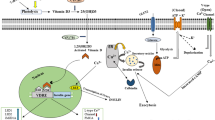Abstract
Aim: Monocyte chemoattractant protein-1 (MCP-1) is a potent chemokine and plays an important role in atherosclerosis of Type 2 diabetes. The aim of this study was to investigate the methylation status of CpG sites in the MCP-1 promoter in Type 2 diabetic patients and its correlation to serum MCP-1 level, and blood glucose level. Methods: The 32 patients with Type 2 diabetes and 15 healthy controls were enrolled into the study. Body mass index, blood pressure, blood lipid, blood glucose, glycosylated hemoglobin (HbA1c), and serum MCP-1 were measured. Genomic DNA was isolated from the peripheral blood mononuclear cells (PBMC). Methylation status of CpG sites in the MCP-1 promoter was determined using methylation specific polymerase chain reaction. Results: The promoter region (2890–3050 bp) was predominantly methylated in PBMC from controls. Methylation of CpG motifs were less methylated in the patients than in the controls (25% vs 80%; p<0.001), while the level of MCP-1 in serum was higher in patients with Type 2 diabetes (193.95±74.96 vs 88.46±55.10; p<0.001). MCP-1 promoter methylation was significantly correlated to serum MCP-1, HbA1c, fasting blood glucose, and triglyceride. Conclusion: These data suggest that hypomethylation of CpG sites in the MCP-1 promoter region may be affected by blood glucose and TG, which then increase the serum MCP-1 level and may play a role in the vascular complications of Type 2 diabetes.
Similar content being viewed by others

References
Nelken NA, Coughlin SR, Gordon D, Wilcox JN. Monocyte chemoattractant protein-1 in human atheromatous plaques. J Clin Invest 1991, 88: 1121–7.
Gerszten RE, Garcia-Zepeda EA, Lim YC, et al. MCP-1 and IL-8 trigger firm adhesion of monocytes to vascular endothelium under flow conditions. Nature 1999, 398: 718–23.
Namiki M, Kawashima S, Yamashita T, et al. Local overexpression of monocyte chemoattractant protein-1 at vessel wall induces infiltration of macrophages and formation of atherosclerotic lesion: synergism with hypercholesterolemia. Arterioscler Thromb Vasc Biol 2002, 22: 115–20.
Esposito K, Nappo F, Giugliano F, et al. Cytokine milieu tends toward inflammation in type 2 diabetes. Diabetes Care 2003, 26: 1647.
Piemonti L, Calori G, Lattuada G, et al. Association between plasma monocyte chemoattractant protein-1 concentration and cardiovascular disease mortality in middle-aged diabetic and nondiabetic individuals. Diabetes Care 2009, 32: 2105–10.
Li H, Deng X, Li Z, Luo C, Liu J, Wang Y. Variation of serum monocyte chemoattractant protein-1 in patients with diabetes and metabolic syndrome. J Huazhong Univ Sci Technolog Med Sci 2011, 31: 312–6.
Davi G, Tuttolomondo A, Santilli F, et al. CD40 ligand and MCP-1 as predictors of cardiovascular events in diabetic patients with stroke. J Atheroscler Thromb 2009, 16: 707–13.
Ueda A, Ishigatsubo Y, Okubo T, Yoshimura T. Transcriptional regulation of the human monocyte chemoattractant protein-1 gene. Cooperation of two NF-kappaB sites and NF-kappaB/Rel subunit specificity. J Biol Chem 1997, 272: 31092–9.
Simeoni E, Hoffmann MM, Winkelmann BR, et al. Association between the A-2518G polymorphism in the monocyte chemoattractant protein-1 gene and insulin resistance and Type 2 diabetes mellitus. Diabetologia 2004, 47: 1574–80.
Turunen MP, Aavik E, Yla-Herttuala S. Epigenetics and atherosclerosis. Biochim Biophys Acta 2009, 1790: 886–91.
El-Osta A, Brasacchio D, Yao D, et al. Transient high glucose causes persistent epigenetic changes and altered gene expression during subsequent normoglycemia. J Exp Med 2008, 205: 2409–17.
Report of the Expert Committee on the Diagnosis and Classification of Diabetes Mellitus. Diabetes Care 1997, 20: 1183–97.
Yu X, Ling W, Mi M. Relationship of impairment induced by intracellular S-adenosylhomocysteine accumulation with DNA methylation in human umbilical vein endothelial cells treated with 3-deazaadenosine. Int J Exp Pathol 2009, 90: 638–48.
Nomura S, Shouzu A, Omoto S, et al. Significance of chemokines and activated platelets in patients with diabetes. Clin Exp Immunol 2000, 121: 437–43.
Piemonti L, Calori G, Mercalli A, et al. Fasting plasma leptin, tumor necrosis factor-alpha receptor 2, and monocyte chemoattracting protein 1 concentration in a population of glucose-tolerant and glucose-intolerant women: impact on cardiovascular mortality. Diabetes Care 2003, 26: 2883–9.
McDermott DH, Yang Q, Kathiresan S, et al. CCL2 polymorphisms are associated with serum monocyte chemoattractant protein-1 levels and myocardial infarction in the Framingham Heart Study. Circulation 2005, 112: 1113–20.
Yuasa S, Maruyama T, Yamamoto Y, et al. MCP-1 gene A-2518G polymorphism and carotid artery atherosclerosis in patients with type 2 diabetes. Diabetes Res Clin Pract 2009, 86: 193–8.
Ng SF, Lin RC, Laybutt DR, Barres R, Owens JA, Morris MJ. Chronic high-fat diet in fathers programs beta-cell dysfunction in female rat offspring. Nature 2010, 467: 963–6.
Yang BT, Dayeh TA, Kirkpatrick CL, et al. Insulin promoter DNA methylation correlates negatively with insulin gene expression and positively with HbA(1c) levels in human pancreatic islets. Diabetologia 2011, 54: 360–7.
Cooper ME, El-Osta A. Epigenetics: mechanisms and implications for diabetic complications. Circ Res 2010, 107: 1403–13.
Baccarelli A, Tarantini L, Wright RO, et al. Repetitive element DNA methylation and circulating endothelial and inflammation markers in the VA normative aging study. Epigenetics 2010, Apr 1 [Epub ahead of print]; doi: 10.4161/epi.5.3.11377.
Reik W, Walter J. Genomic imprinting: Parental influence on the genome. Nat Rev Genet 2001, 2: 21–32.
Herder C, Baumert J, Thorand B, et al. Chemokines as risk factors for type 2 diabetes: results from the MONICA/KORA Augsburg study, 1984–2002. Diabetologia 2006, 49: 921–9.
Herder C, Baumert J, Thorand B, et al. Chemokines and incident coronary heart disease: results from the MONICA/KORA Augsburg case-cohort study, 1984–2002. Arterioscler Thromb Vasc Biol 2006, 26: 2147–52.
de Lemos JA, Morrow DA, Sabatine MS, et al. Association between plasma levels of monocyte chemoattractant protein-1 and long-term clinical outcomes in patients with acute coronary syndromes. Circulation 2003, 107: 690–5.
Hoogeveen RC, Morrison A, Boerwinkle E, et al. Plasma MCP-1 level and risk for peripheral arterial disease and incident coronary heart disease: Atherosclerosis Risk in Communities study. Atherosclerosis 2005, 183: 301–7.
Lim SO, Gu JM, Kim MS, et al. Epigenetic changes induced by reactive oxygen species in hepatocellular carcinoma: methylation of the E-cadherin promoter. Gastroenterology 2008, 135: 2128–40, 2140.e1-8.
Beckman KB, Ames BN. The free radical theory of aging matures. Physiol Rev 1998, 78: 547–81.
Wachsman JT. DNA methylation and the association between genetic and epigenetic changes: relation to carcinogenesis. Mutat Res 1997, 375: 1–8.
Kamei Y, Suganami T, Ehara T, et al. Increased expression of DNA methyltransferase 3a in obese adipose tissue: studies with transgenic mice. Obesity (Silver Spring) 2010, 18: 314–21.
Jiang Y, Zhang J, Xiong J, et al. Ligands of peroxisome proliferator-activated receptor inhibit homocysteine-induced DNA methylation of inducible nitric oxide synthase gene. Acta Biochim Biophys Sin (Shanghai) 2007, 39: 366–76.
Malanovic N, Streith I, Wolinski H, Rechberger G, Kohlwein SD, Tehlivets O. S-adenosyl-L-homocysteine hydrolase, key enzyme of methylation metabolism, regulates phosphatidylcholine synthesis and triacylglycerol homeostasis in yeast: implications for homocysteine asa risk factor of atherosclerosis. J Biol Chem 2008, 283: 23989–99.
Author information
Authors and Affiliations
Corresponding author
Rights and permissions
About this article
Cite this article
Liu, Z.H., Chen, L.L., Deng, X.L. et al. Methylation status of CpG sites in the MCP-1 promoter is correlated to serum MCP-1 in Type 2 diabetes. J Endocrinol Invest 35, 585–589 (2012). https://doi.org/10.3275/7981
Accepted:
Published:
Issue Date:
DOI: https://doi.org/10.3275/7981



